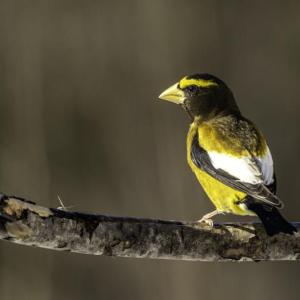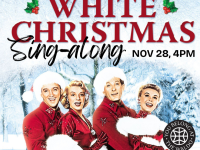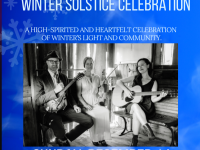What are Evening Grosbeaks Hiding?
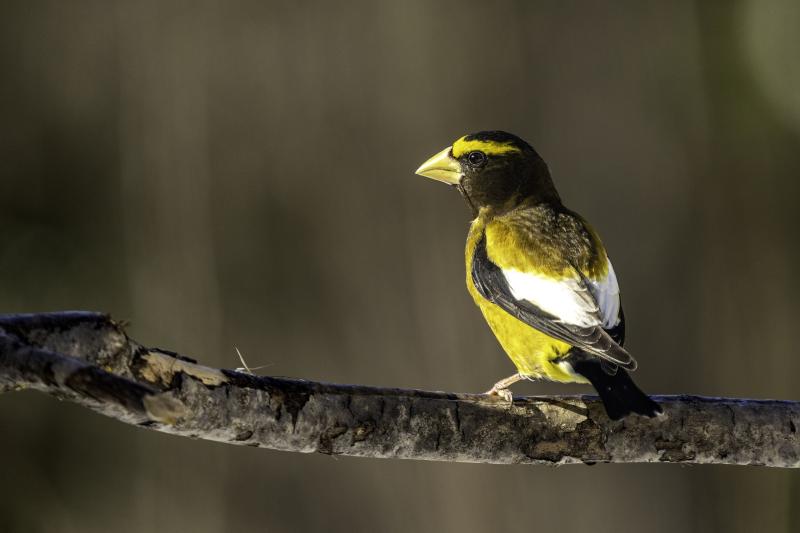 This evening grosbeak was photographed in northern Minnesota. Note the large bill and bright yellow body. Photo courtesy of Lauri Shaull, wikimedia commons
This evening grosbeak was photographed in northern Minnesota. Note the large bill and bright yellow body. Photo courtesy of Lauri Shaull, wikimedia commons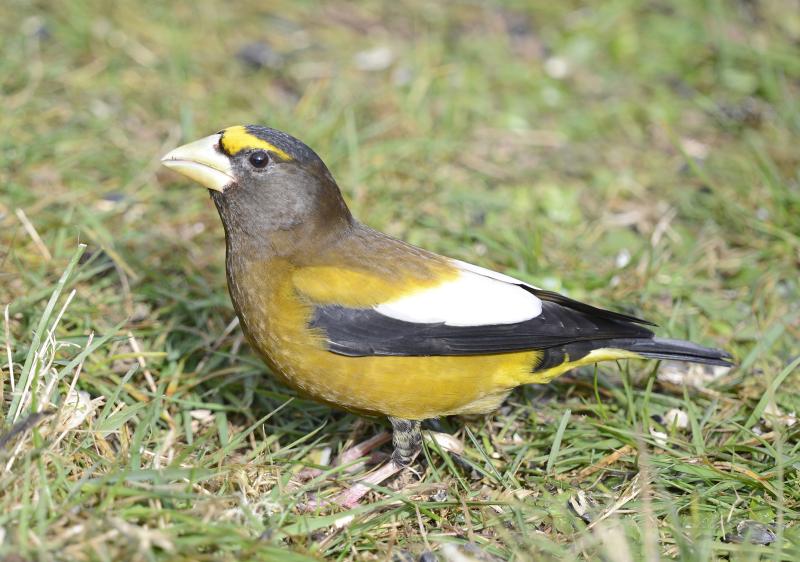 Does this male evening grosbeak from Washington state look obviously different from the bird in the above photo? Photo courtesy of Vickie J Anderson , wikimedia commons
Does this male evening grosbeak from Washington state look obviously different from the bird in the above photo? Photo courtesy of Vickie J Anderson , wikimedia commons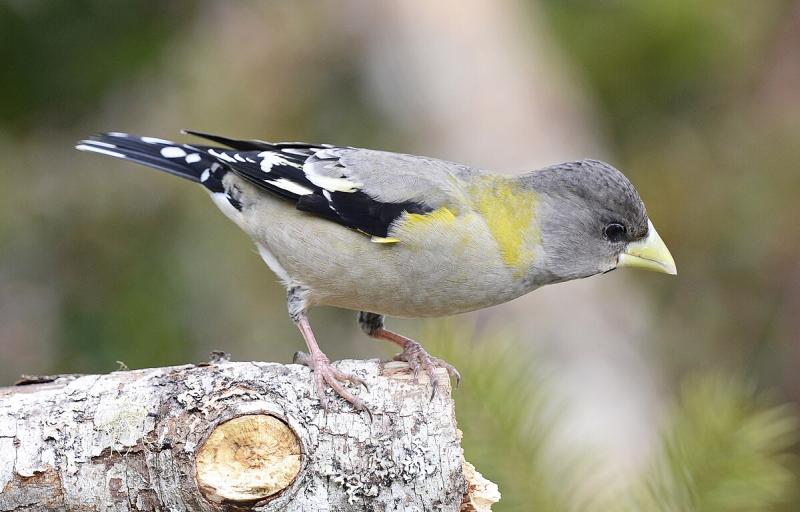 Female evening grosbeaks have an unusual gray-green color but, like the males, also have a large bill. Photo courtesy of Vickie J Anderson , wikimedia commons
Female evening grosbeaks have an unusual gray-green color but, like the males, also have a large bill. Photo courtesy of Vickie J Anderson , wikimedia commons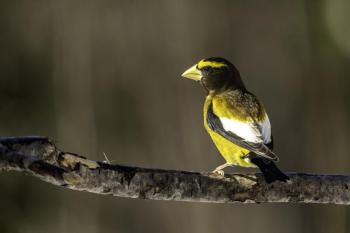 This evening grosbeak was photographed in northern Minnesota. Note the large bill and bright yellow body. Photo courtesy of Lauri Shaull, wikimedia commons
This evening grosbeak was photographed in northern Minnesota. Note the large bill and bright yellow body. Photo courtesy of Lauri Shaull, wikimedia commons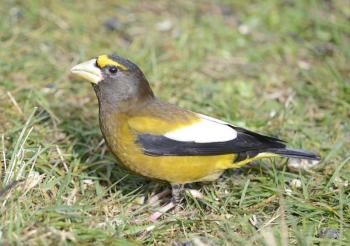 Does this male evening grosbeak from Washington state look obviously different from the bird in the above photo? Photo courtesy of Vickie J Anderson , wikimedia commons
Does this male evening grosbeak from Washington state look obviously different from the bird in the above photo? Photo courtesy of Vickie J Anderson , wikimedia commons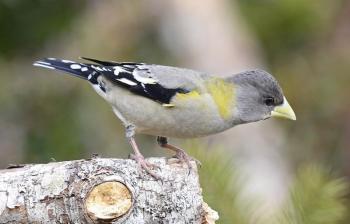 Female evening grosbeaks have an unusual gray-green color but, like the males, also have a large bill. Photo courtesy of Vickie J Anderson , wikimedia commons
Female evening grosbeaks have an unusual gray-green color but, like the males, also have a large bill. Photo courtesy of Vickie J Anderson , wikimedia commons
Sometimes we birders can be lulled into thinking that once we’ve figured out that the yellow bird on the backyard feeder is an evening grosbeak, not an American goldfinch, we know everything we’ll ever know about the evening grosbeak. But what if that evening grosbeak was hiding something from us? What if there were different kinds of evening grosbeak (beyond female, male, and immature)?
In case you haven’t thought about evening grosbeaks for some time (and you may not have, since there haven’t been many around our area in years), they are a stocky finch with an almost shockingly massive bill. The males have bright yellow undersides, lower back and eyebrows and black tail and outer wings with a contrasting bright white patch on the inner wing. Females are an unusual green-gray color on the body, often with a bright yellow patch somewhere on the head or neck.
Back in the 1970s and 1980s, flocks of these remarkable birds would descend on bird feeders by the dozens, occasionally even more than a hundred at a time. The show was incredible to watch. Unfortunately, evening grosbeak numbers have declined by 80% or more since those times, across their North American range, and its more unusual now to any, let alone a whole flock.
Evening grosbeaks have a breeding range that extends across the Boreal Forest from northern and eastern Maine north to Newfoundland and west to British Columbia (barely into southern Yukon and Northwest Territories). In the West, they nest at higher elevations south into Mexico.
You’d be hard pressed to see any difference between an evening grosbeak in Maine and one in British Columbia or California or Mexico. But about 20 years ago, some researchers found that the calls of evening grosbeaks differed in different regions. They found that ones in the eastern U.S. were different from ones in the western U.S. and that there were at least two other variants in parts of the western U.S. But they didn’t have that many call samples and they were missing call recordings from a very large part of the range including the entire Boreal Forest region of Canada, which makes up the largest part of the species’ breeding range.
Our friend from our Cornell Lab of Ornithology days, Matt Young, founder of the Finch Research Network, joined in with five other researchers to probe more into the mysteries of the call types of evening grosbeak. They published a paper in August 2025 that analyzed 239 recordings contributed by volunteers (maybe some of you, since there were a few samples from Maine!) to the sound archives of the Macaulay Library at the Cornell Lab of Ornithology.
This new research confirmed the four previous evening grosbeak call types and better delineated where they occurred. But it also added some new twists, including a new call type in the central Canadian portion of the Boreal Forest breeding range. Even more mysteriously, that call type was most similar to the few calls that they had from Mexico and southeastern Arizona.
So maybe there are five or six different kinds of evening grosbeak? Hopefully, this research is inspiring more birders to make recordings of evening grosbeaks (you can do it with your cell phone nowadays) and submit those recordings to eBird.
We anxiously await the next installment in the hidden biodiversity in the mysterious evening grosbeak.
The paper is called “Quantitative analysis of the flight calls and trills of Evening Grosbeaks (Coccothraustes vespertinus)” You can read it at: https://doi.org/10.3389/fbirs.2025.1613273
Jeffrey V. Wells, Ph.D., is a Fellow of the Cornell Lab of Ornithology and Vice President of Boreal Conservation for National Audubon. Dr. Wells is one of the nation's leading bird experts and conservation biologists. He is a coauthor of the seminal “Birds of Maine” book and author of the “Birder’s Conservation Handbook.” His grandfather, the late John Chase, was a columnist for the Boothbay Register for many years. Allison Childs Wells, formerly of the Cornell Lab of Ornithology, is a senior director at the Natural Resources Council of Maine, a nonprofit membership organization working statewide to protect the nature of Maine. Both are widely published natural history writers and are the authors of the popular books, “Maine’s Favorite Birds” (Down East Books) and “Birds of Aruba, Bonaire, and Curaçao: A Site and Field Guide,” (Cornell University Press).

